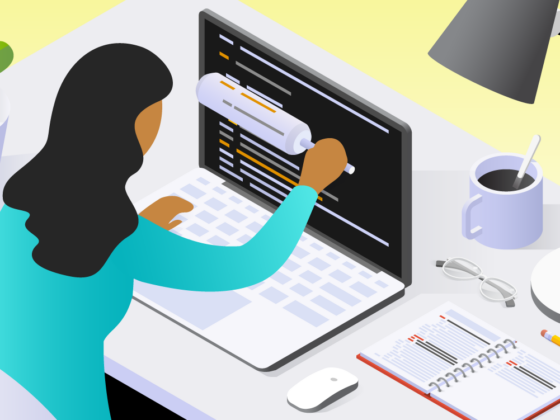Introduction
In the first article in this series on Flexion’s apprenticeship program, FlexUp, Part One: Investing in diverse thinkers and problem-solvers, we talked about the goals of this effort, how participants are recruited, the diversity and commonalities among apprentices, and their reasons for joining the program. In Part 2, we’ll explore the process apprentices go through as they enter the program and the types of training they receive.
Adding a new discipline to the program
The recruitment team will select one UX designer to join the FlexUp apprenticeship program for the first time. “We are excited to offer a UX Designer role as part of FlexUp,” says Chris Giese, who leads the recruitment effort. “We have a robust support system to provide an excellent experience.”
Sarah Ruggless, part of the Delivery Leadership Team, says, “After graduating two successful cohorts of engineering apprentices, we are ready to expand into different disciplines. As our UX capabilities grow, we want to add UX apprentices to learn how Flexion incorporates UX research and design into our cross-functional teams.”
Senior UX designers Katie Cissell and Sui Wong will mentor the apprentice selected for the UX position. This individual will follow similar steps as the engineering apprentices but will have their own UX problems to solve. “We expect the UX apprentice to collaborate with the team on finding the right solution for a specific UX problem,” says Katie. “We’ll support them as they jump in with us through the entire design process.”
The UX apprentice will work on the United States Tax Court project (DAWSON) for the three months of their apprenticeship. “Ninety days is not enough time to become a subject matter expert on DAWSON and the tax court procedures. So, the UX apprentice will get an overview of the system,” Sui says, “We’ll have working sessions to see how they would approach select stories in the backlog. We will guide them through the team’s process of brainstorming and collaboration. Ideally, the UX apprentice will be involved in research and design.”
Inside the structure of the FlexUp program
The FlexUp program has a deliberate structure designed by Flexion leadership to mirror how full-time senior software engineers and UX designers initiate and develop their relationship with the company.
Step 1: The interview process
Once the program’s applications are closed, the internal selection team reviews each applicant’s information and selects the most likely candidates to succeed as junior engineers or UX designers.
“To get into the program, applicants must undergo the same interview process that regular employees undergo, including the code challenge for engineers and a design challenge for UX candidates,” says Tom Willis, one of the program leaders.
Interviewees will also have an opportunity to ask questions about Flexion and to hear information about the Flexion Fundamentals, which are the company’s guiding principles.
Step 2: Onboarding
After we select apprentices for both disciplines, onboarding begins. Once Flexion brings apprentices on board, they get their team assignment. Willis says, “From then on, their number one job is to be a good teammate eager to learn.”
Former engineering apprentice Miriam Miest-Moore says, “Flexion has set up the (training) program well. We were expected to participate with our team and find out where we could add value. That was the emphasis, not writing code. The team accepted us as Full Stack developers from the start.”
Regarding the UX candidate, Katie says, “I’m excited about what questions the UX apprentice will ask us. Anytime someone new looks at our work or processes, you can learn new things from their eyes.”
Step 3: The Training Begins
The technical aspects
On the technical side, engineering and UX apprentices receive Flexion-specific training. For the engineering apprentices, training includes workshops on scrum and agile methodologies, collaborative coding and pairing, clean software architecture, vertical slices, and user stories. According to Sui, the UX apprentice will participate in training sessions that are relevant to them, such as workshops on scrum and agile methods, vertical slides, and user stories.
Self-directed learning
All apprentices will engage in self-directed learning. “Flexion makes a plethora of resources available to their apprentices,” says Carlos Peña, a former apprentice. “The learning opportunities were much greater than I thought they would be. And there are also the internal Slack channels where you can reach out to people with years of experience, including Senior Leadership, for advice.”
While still in the training program, Desiree Bradish attended a course on accessibility given by Marcy Sutton, an expert in the field. “I’m extremely passionate about accessibility in general,” Desiree says, “so it was a pleasure to gain insights on making my team’s project accessible from the ground up.”
Mentorship
Leadership assigns each apprentice to a team almost from day one. They also get a mentor outside their team who can help them navigate the Flexion ecosystem and get oriented to technical and agile teamwork perspectives. Carlos had Tom as his on-team senior mentor. “Tom was and still is a great help whenever I have technical or company questions. He helped me navigate the apprenticeship and the onboarding process in general,” Carlos says.
Jose Alba was Salome Ranson’s apprentice mentor (a graduate of the apprenticeship program). “We met often to discuss my progress,” Salome says, “and used a Trello board to track what I accomplished, what I was currently working on, and what was left for me to complete in terms of the tech stack, Flexion training, team contributions, and more. Jose advised me on preventing burnout and getting the most out of my apprenticeship experience. He was a gem and provided a safe place to be vulnerable and honest about my experience.”
Jose, a former apprentice himself, also mentored Scott Pawlak. Scott says, “Getting advice from someone who has been through the same thing you’re going through really resonates.” Jose told Scott that things would “click” and make sense one day and that the feeling of not knowing what you were doing would disappear. Scott says that proved to be true. “There came the point in the training where it was a challenge, but now it’s a challenge I love.”
While mentoring helps the mentee, it is also a valuable experience for the mentor. A Technical Systems Architect, Peter Kendall has mentored two apprentices, including Miram Miest-Moore. “Mentoring people has honed my ability to break down and explain complex topics,” Peter says. “This has led me to be a more effective leader of software engineering teams and to better collaborate with clients.”
UX mentors Katie and Sui can’t wait to be mentors for this program. Sui says, “I like this program’s mission and hope it benefits Flexion with additional UX talent. Even if the person doesn’t end up on a project at Flexion, I hope we can empower them with the skills and knowledge they picked up and will pay it forward.”
Step 4: Learning the Flexion Fundamentals
In addition to all the technical training, apprentices receive training in the Foundations of Flexion Fundamentals, which are critical principles used to promote option-based thinking as a guide for decision-making at the company.
Andrew Shumway, now a full-time Full Stack Engineer and a program graduate, urges apprentices to pay close attention to the Fundamentals. “The company believes in them. Learn them and try to live by them in your career at Flexion.”
Carlos agrees, “The emphasis of the apprenticeship is not the technical information. The challenge is to discover how well you can work within the Flexion ecosystem using the Flexion Fundamentals as your guide.”
While each of the twelve Flexion Fundamentals applies to enrollees in the FlexUp apprenticeship program, as they do to all full-time employees, the following fundamentals reflect critical attributes of the training.
01 – Embrace diversity.
“We value diverse opinions, backgrounds, and experiences by providing a safe, inclusive environment where everyone can speak their minds — we not only encourage candor, but we owe it to each other.”
09 – Never stop learning.
We each have a few core skills, but we eagerly and quickly learn new ones to deliver innovative products. We have a growth mindset and never say, “That’s not my job.”
12 – Walk multiple paths.
Knowing which ideas will succeed is impossible when solving complex problems. So, we improve our chances of success by pursuing multiple options concurrently.
While each fundamental stands on its own, when blended, it helps tell the story of a company committed to doing its best for its clients and employees, expecting the same in return.
Step 5: Graduation
Once the training is complete, accepted apprentices celebrate their offers for full-time employment at the company.
“The biggest value,” says Miriam Miest-Moore, who graduated a few years ago, “is that you may get to stay at Flexion.” And that value grows over time. “Once you’re here, you don’t get pigeonholed. Change teams if you want to explore opportunities. You get to drive your career.”
What’s next?
If you want to apply for the FlexUp program, watch our Careers page for announcements.
Stay tuned for the third and final post in our three-part FlexUp series, or get caught up by reading the first post, Investing in diverse thinkers and problem-solvers.




